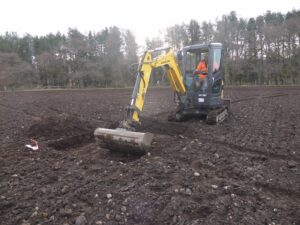
Successful archaeology depends on the collection and study of evidence. It has developed over the years into a multi-faceted profession in which few grasp the full details of more than a handful of the possible specialisations into which we divide. The subjects we embrace can be as diverse as the social structures within hunter-gatherer societies, the isotope analysis of bones, DNA studies, animal migrations, flintknapping techniques, and detailed investigations of residues. It has become a forensic science.
The building blocks on which we rely comprise data which is used as evidence. That evidence is drawn from many different elements: it might comprise artefacts, bones, or soil samples, amongst other things. Archaeologists have to relate that evidence to the location where they find it. We study it, interpret it and construct a narrative that sets out how it relates to history, to the story of that place and its people.
On occasion, evidence is missing. This is most commonly due to local preservation conditions. Human bone is, for example, relatively rare on many early prehistoric sites, and this is often due to acid soil conditions which are not favourable for bone preservation. It is also, in some instances, due to practices which meant that bone (or whatever the subject of interest is) was not, by and large, deposited on that particular site. On these occasions, it is up to us, as archaeologists, to work out why something is missing. It becomes part of the story.
Very occasionally, where evidence has been absent, new research might reveal it. Sometimes our own prejudices have obscured our view; it is hard to recognise something if you do not think it should be there. Sometimes, new techniques or new circumstances reveal something that was previously unexpected. In general, the discovery of a new aspect of past life in a site or region is an exciting matter. It is a big step forward. It helps us to understand that region better. But, it is, in fact, much more than that. It also forces us to rethink the histories of other regions, in particular those that border our area of study. If, for example, you once thought somewhere to have been uninhabited, how exiciting to find traces of a population. How did they live? How did they interact with those around them? Many stories have to be rewritten. And, not least, why have we missed them in the past? How can we find out more about them? What happens if we apply these new techniques to the wider area, how does it impact on our understanding of the greater histories. It promises a whole new research environment.
I’ve written about this before with regard to Palaeolithic Scotland. For most of my professional life conventional wisdom dictated that Scotland was uninhabited in the Palaeolithic (Late Pleistocene). Indeed, when I was a student most people considered that the north of Scotland had been uninhabited until the Neolithic, some 6000 years ago. Finding evidence for Mesolithic settlement dating back some 8000 years on the island of Rum in the 1980s was more daring than I had originally realised.
Mesolithic Scotland is old hat now, and the first evidence for Palaeolithic (Late Upper Palaeolithic, or LUP, to be precise) activity here has moved from being tentative to well established. I feel privileged to have seen this change; it was a good move, (had I but known it), to specialise in something so obscure as the earliest settlement of Scotland when I graduated.
There is still a lot of work to do, nevertheless, before the picture of Palaeolithic Scotland can take its place in our understanding of the Northwest Europe. The picture is patchy and relies strongly on chance findings of stone tools. It is an exciting time to be working here. There is a whole new field of study and we have to build a framework to gather the wider evidence. We need to go back to basics and devise a plan of action. This excitement extends to our European colleagues who, particularly those in Scandinavia, are waiting to join forces and look at the bigger picture. The discovery of Late Pleistocene populations in Scotland will inevitably impact on their own regions.
For these reasons I was somewhat surprised recently to hear that a grant application had been turned down on the grounds that the recent recognition of evidence for LUP archaeology in Scotland was not of wider significance. Of course, the fault is ours for not emphasising the ways in which we will need to develop new approaches to find and investigate the evidence that has, to date, remained so elusive. Obviously, we did not draw enough attention to the interest this has generated among our colleagues in Europe. It is a reminder of the ways in which we can become complacent and assume that others share and understand our own excitement. When you work in a particular research environement it can be easy to forget that not everyone will share your perspective.
Weirdly, I also feel that it is a reminder of the ways in which understanding has changed. Research was very different for those of us who lived in a time when gaps in our knowledge were frequent. Today, we have more information and we can all become very focussed on small details. We should never take the wider picture for granted.
You must be logged in to post a comment.